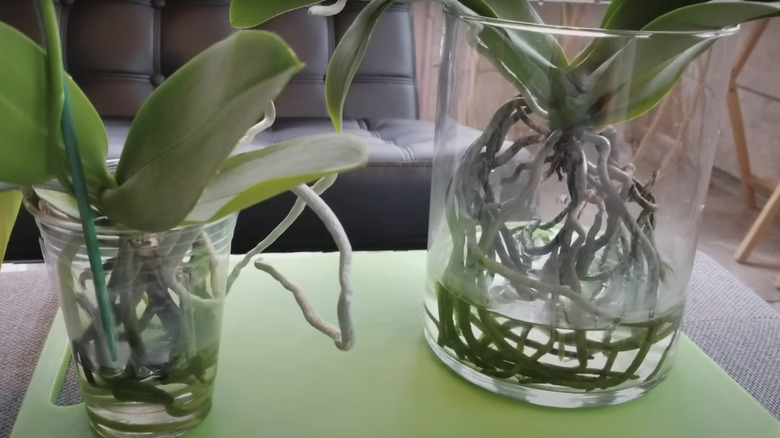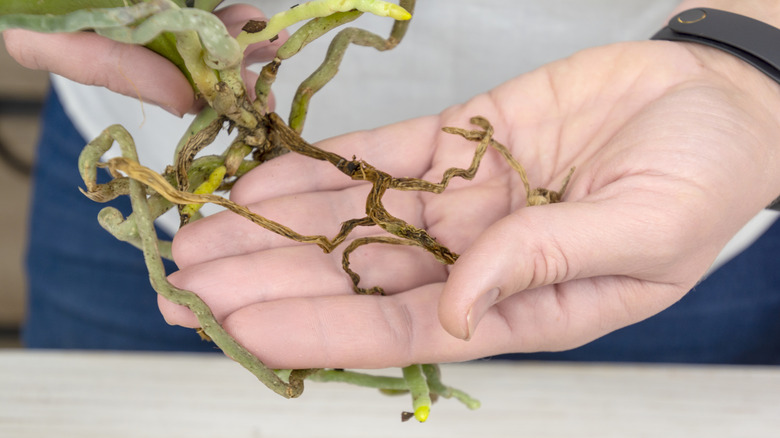Common Mistakes To Avoid When Growing Orchids In Water
Orchids have a reputation for being finicky and difficult to grow, and one of the things that's sure to kill an orchid is overwatering it. It may seem counter-intuitive, then, that growing orchids in water is possible. It's true that it can be harder to do successfully, but as long as you avoid common mistakes like keeping the roots fully submerged, choosing the wrong species, not preparing the plant, and using unfiltered water, you can grow beautiful, healthy orchids hydroponically.
Orchids are more often grown in a growing medium like coconut husk or bark than in water. Their roots are known for being sensitive to moisture; too much exposure to water, and they will quickly begin to rot. Growing orchids in water can actually eliminate this worry since you no longer have to water the plant in the traditional sense. Also, this method allows you to easily see the roots and address any issues right away, which is key to a thriving orchid plant.
In nature, most orchids grow on the surface of other plants. They produce regular roots that go down into the soil, as well as lots of aerial roots that soak up moisture from the air. Aerial roots are not designed to stay wet for long — and that applies to growing orchids in water as well as soil. Whereas you might be able to keep other plants in water full-time, orchids often require a more balanced approach.
Submerge orchids with caution
The first common error to avoid is exposing an orchid's roots to too much water. Submerging the roots may seem like the obvious way to go, but orchids can't handle that much moisture for very long; you will end up with rotten roots if you do this. Instead, many people practice "semi-water culture" for orchids, in which the plants stay submerged only part-time. The routine typically goes something like this: Soak the orchid's roots for a couple of days, and then empty the water and let them dry out for a few more days.
Soaking too often is another potential mistake; you should soak the roots only when they appear silver. When they're green, they have plenty of moisture already. Generally, you should soak less often when the orchid is dormant and more often when it's actively growing. Full water culture, in which the roots stay in water full-time, is also an option, but those who use this method typically submerge the roots only up to a certain level, leaving the rest exposed to air so the plant can still access oxygen. The water should cover one-third to two-thirds of the roots, depending on the species.
That leads us to the second common mistake. You may be tempted to try water culture with whatever orchid you happen to have on hand, but not choosing the right type of orchid can lead to disappointing results. Some orchids prefer drought conditions, like Cattleyas or Oncidiums, so they're not good candidates to grow in water. Instead, look for species with thick roots that tolerate more moisture. Luckily, the most common indoor orchids, Phalaenopsis orchids, fall into this category, as do Vandas and antelope-type Dendrobiums.
Never skip preparation
Another common mistake is taking an orchid from its current pot and moving it to water right away. Changing environments is a stressful event for a plant, and there are important steps to take to set your orchid up for success before it does any soaking. Patience is key; it can take up to six months or even a year to fully acclimate your orchid to its new conditions.
Instead, first prepare the plant by washing off all of the growing medium from the roots; debris in the water will lead to rot and mold. Prune dead or damaged roots, which will also rot if they sit in water. For full water culture, some people trim away the old roots in general, but be careful not to remove too many and over-stress the plant. You do, however, need to slowly acclimate your orchid to a full water culture setup by gradually increasing the water level over the course of two to three weeks. It's also helpful to let the roots dry out for a day or two beforehand, as they will form a protective callus that helps protect the plant during the transition.
Lastly, avoid the mistake of giving your orchids regular tap water. Tap water usually contains dissolved minerals, and these may accumulate on the orchid's roots over time. Instead, use filtered water only; reverse osmosis and distillation are the two most effective methods of filtration for removing minerals from water.


